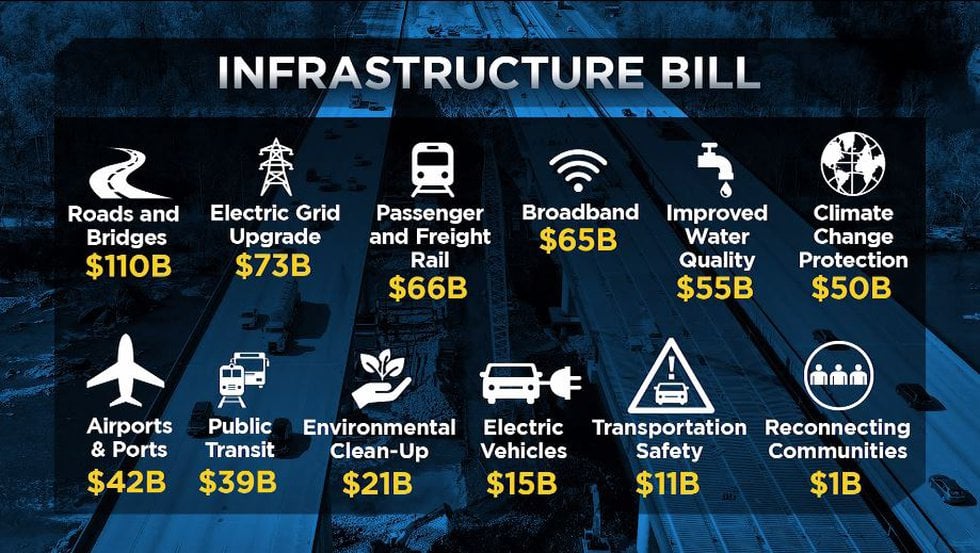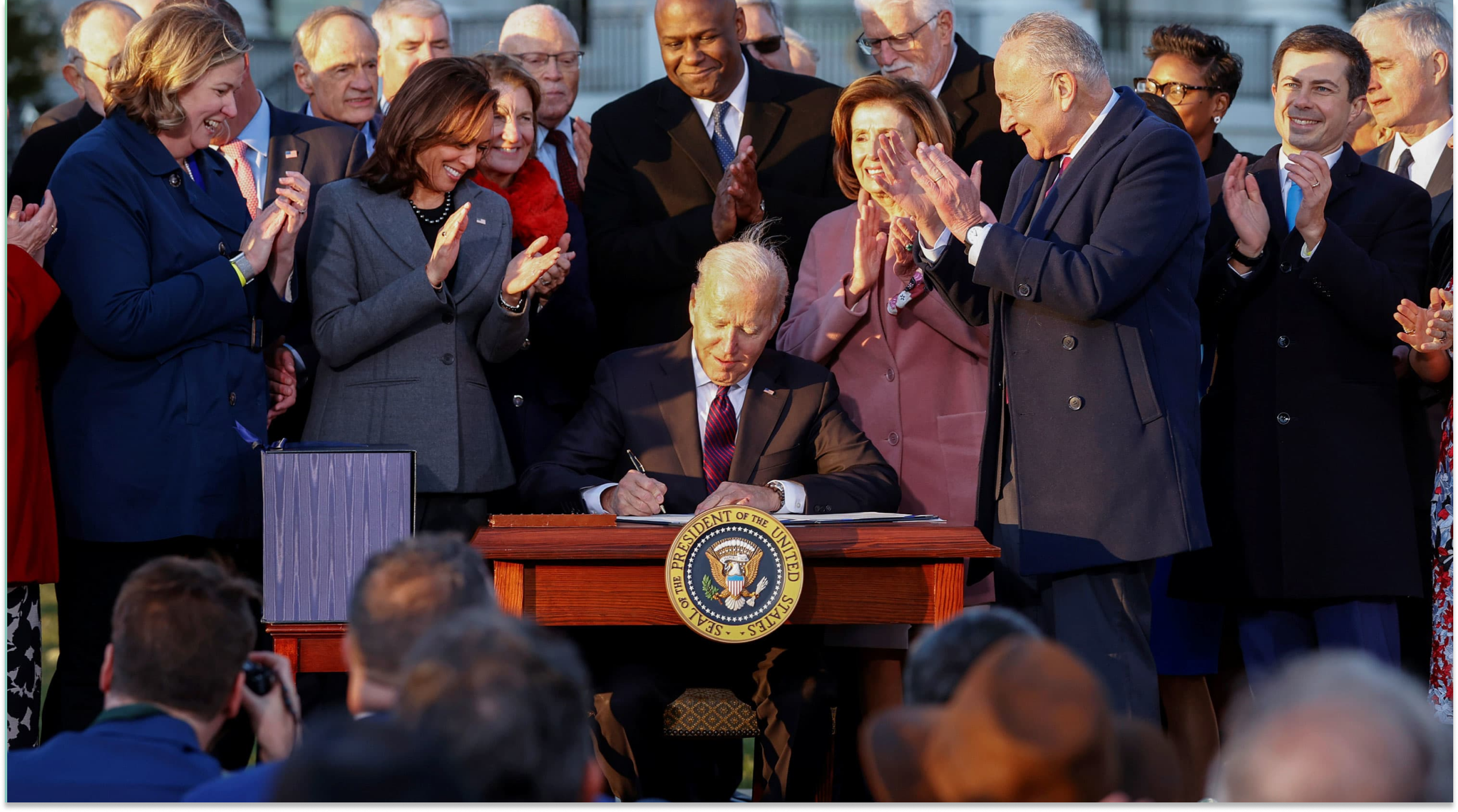What is the New Infrastructure Bill?
On Monday, November 14th, President Biden signed the latest infrastructure bill into law jumpstarting a spending agenda that will allocate around 1.2 trillion dollars towards the updating of local governments as well as key infrastructure pieces like roads, bridges, and transit systems. Biden first debuted his infrastructure proposal in March, months of bipartisan negotiations yielded about $800 billion in cost cuts from the original plan. Congress ultimately decided to cut the infrastructure bill's investments by as much as 50% across the board despite the many improvements included.
The Bipartisan deal aims to rebuild many of the country’s failing infrastructures with new focuses on providing access to clean drinking water in the country as well as huge steps towards high-speed internet across the nation something the new digital age has brought to the forefront. The bill also focuses on improvements to our electrical grid, water pipelines, and transportation. These new updates will require a significant expansion of construction and manufacturing worker pools as skilled workers will be vital in completing these new projects. The legislation will also help to alleviate growing pressures and strengthen supply chains by making overdue improvements. The new law will also look to drive an increase in well-paying jobs focused on growing the economy for the future.

Graphic Provided by CNN Network and WBTV
What Does this New Bill Hope to Accomplish?
Headlining the massive infrastructure bill’s spending, roughly $110 billion of new funds will go toward improving the nation's roads, bridges, and investments in other major transportation programs. Around $39 billion will be set aside for expanding transportation systems, improving accessibility for people with disabilities, while also providing dollars to state and local governments to buy zero-emission and low-emission buses. The deal will also look to invest about $55 billion to expand access to clean drinking water for households, businesses, schools, and childcare centers across the nation. There are also sections included that address the problems with lead service pipes especially in places like Tribal Nations and disadvantaged communities that need it most.
Another vital aspect of this bill is the new dedication to the electric grid as well as the promotion of electric vehicles. Johnathan Ponciano from Forbes outlined some of these investments made stating,
“A $108 billion investment will help upgrade the nation’s electricity grid, with thousands of miles of new transmission lines and funds for environmentally friendly smart-grid technology. In addition to $7.5 billion for the nation’s first network of electric-vehicle chargers along highway corridors, lawmakers have shored up $5 billion for zero-emission buses (including thousands of electric school buses) and $2.5 billion for ferries.”
Johnathan Ponciano, Forbes Magazine
Lawmakers also aim to increase the access every American has to reliable high-speed internet. Wireless internet is almost a necessity for Americans to do their jobs in today’s modern society. Despite the vast increase in people participating in online and remote work more than 30 million Americans live in areas where there is no broadband infrastructure or one that provides drastically slow speeds. This problem is experienced by many who live in rural communities throughout the country. According to some of the most recent OECD data from the 35 countries studied, the United States has the second-highest broadband costs. The Infrastructure Deal will deliver $65 billion to help ensure that every American has access to reliable high-speed internet while also helping to lower prices for the service inching closer to eliminating the digital divide so that more Americans can afford reliable internet access.

Image provided by GETTY
What Does This Mean for Apprenticeship?
When President Joe Biden signed the new Infrastructure bill into law in November, the deal happened to fall on National Apprenticeship Week, an annual celebration of registered apprenticeship programs' opportunities, successes, and contributions across the country. This was a happy coincidence as the infrastructure bill will benefit apprenticeships greatly as its workforce development allocations will make sure that apprentices and apprenticeship programs are an integral part of the climate solution, training creation, and careers in the building trades to fight climate change. Despite the nearly 200,000 registered apprenticeship programs developed in the construction and manufacturing industry, a majority will not be able to meet the increasing demand for skilled workers. Increasing the amount of funding to these apprenticeship programs will help to generate more skilled workers and attract more participants.
Paul Nolley a Rockford Register Star Contributor and Executive Director of Project First Rate believes the bill will infuse the industry with much-needed funding stating,
“There are $74 billion earmarked for workforce development programs related to careers in building trades and other fields, including expanding registered apprenticeship programs. These programs, typically run in a joint labor-management model in the union construction field, represent meaningful alternatives to four-year university programs and offer workers the opportunity to build a craft and start a career they will have for life.”
Paul Nolley, Rockford Register Star
With the new wave of workers who are leaving their current work and looking for a change, there will be a growing need for skills training and development in order to retrain and upskill the current workforce. The infrastructure bill includes an unprecedented scale of work and projects will soon break ground across the country. This investment in our country’s infrastructure will come with a greater demand for skilled workers, the expansions planned in the bill will also require countless new skilled, union workers.
The federal infrastructure law addresses these needs by allocating tens of billions of dollars worth of funds in workforce development infrastructure and worker protection. This will go along with the creation of around 1 to 2 million new registered apprenticeship slots. A heavy focus will also be given to pre-apprentice and direct-entry programs as they have become a centerpiece of the construction industry. These programs provide opportunities for entry-level workers to receive job and safety training both on-site and in the classroom. By creating a vast number of well-paying jobs and also providing the country with a way solid plan to lift the pay of workers who are without college degrees as well as making sure women, people of color, and the disadvantaged can successfully train for these new opportunities.






.png)

